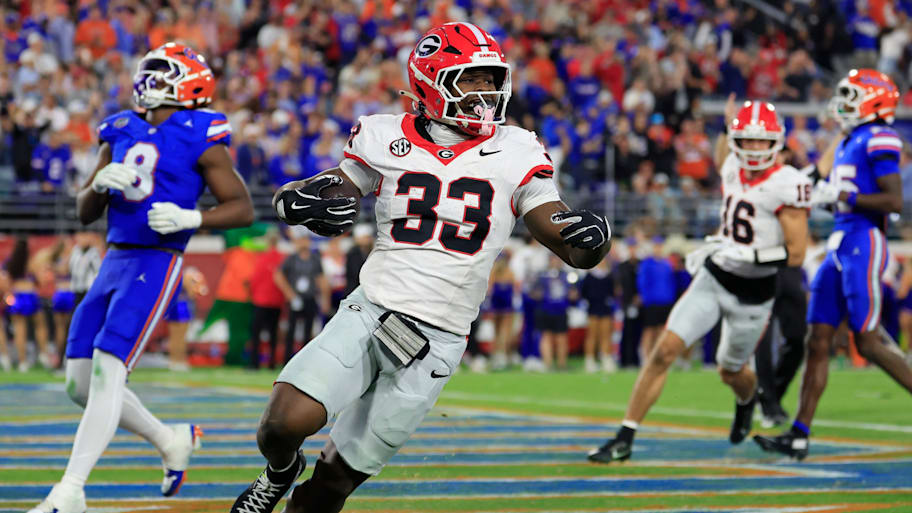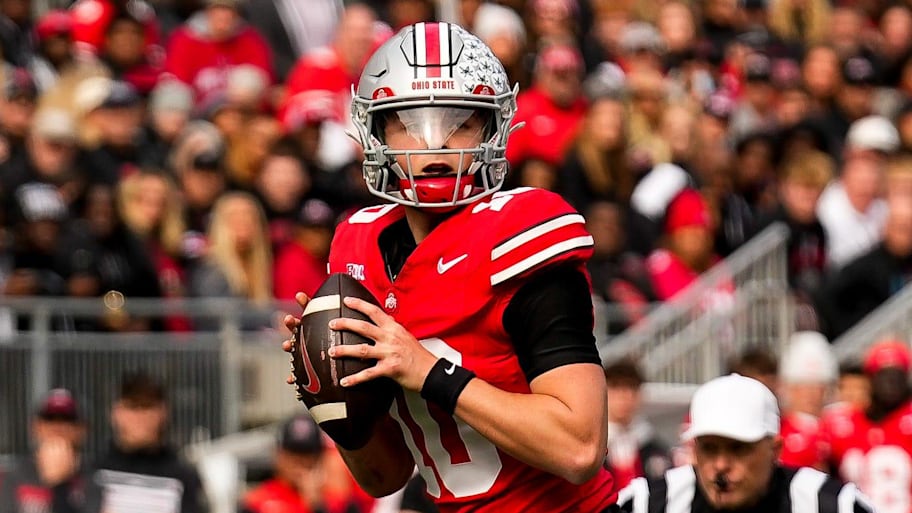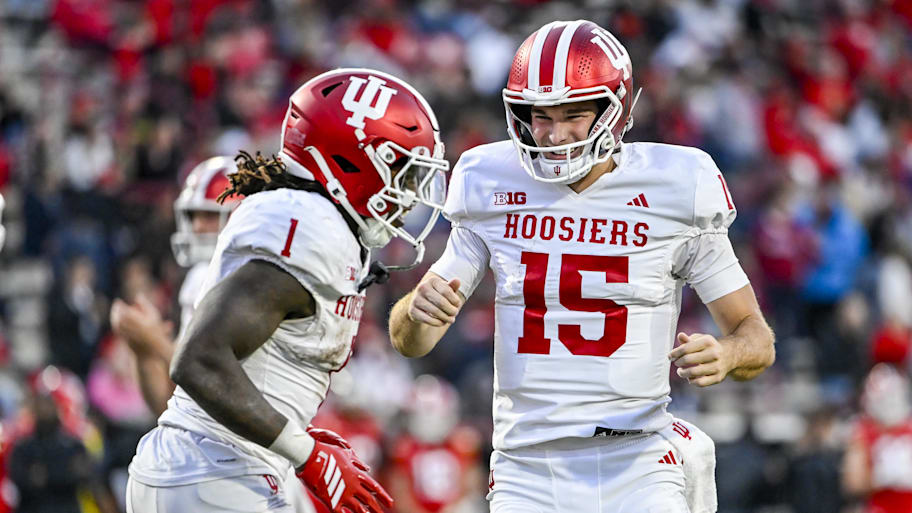We’ve made it.
It’s officially crunch time in the race to make the College Football Playoff and now we hit another mile-marker on the road to crowning a national champion as we start getting some insight as to what the selection committee is thinking about teams, conferences and résumés with its first Top 25 released on Tuesday.
While it’s always good to try to parse out just what the committee values at this point in the season, it’s particularly of note after a wild Week 10 saw several potential playoff teams take unexpected losses and a handful of conference contenders saw their path to the first weekend in December change, while the at-large picture continues to look muddled even more so than last season.
So, what is top of mind for the committee? Here are five key questions going into Tuesday’s show.
1. Who has the edge for multiple bids, the ACC or the Big 12?
Big 12 commissioner Brett Yormark has been vocal since the summer about getting multiple playoff bids for his league after the ACC snuck both SMU and Clemson into the field in 2024. That’s unsurprising optimism coming out of the league office, but it won’t be as simple as wishing it to be the case given how jumbled the CFP picture is for both conferences.
Right now, it’s probably a safe assumption to think that undefeated BYU and one-loss Texas Tech will sit inside the top 12 come Tuesday. But the Big 12’s ability to place both (or another team from the league) will likely come down to which other programs might be in the committee’s Top 25 as a way to give the conference additional victories over ranked teams. For example, Utah being ranked inside the top 15—they’re No. 17 in the AP poll this week—could be great news for the Big 12 and it will definitely help if Cincinnati is ranked given that the Bearcats host the Cougars later this month.
As for the ACC, they’re in a similar predicament of trying to stack the Top 25 with as many conference teams as possible so they can slot in two and avoid having only the automatic bid in the bracket. Pay particular attention to what the committee thinks of Georgia Tech after the Yellow Jackets suffered their first loss, how high Virginia is after several close calls and if Louisville is a threat. Then there’s Miami, which likely needs to be the top two-loss team if it wants to feel better about its chances of earning an at-large bid given how difficult it will be to get to the ACC title game.
It could also be instructive to see if the committee ranks either (or both) SMU and Duke given they are alive in the ACC title race despite their overall records.
2. What’s the SEC pecking order of contenders?
It’s pretty easy to see Texas A&M and Alabama in a class of their own in the SEC, but how does the committee view the slew of other contenders who are also firmly in the mix of the playoff discussion? Georgia has been surviving some close calls the last few weeks. You wonder if the Bulldogs could be a touch lower than the No. 5 spot they are in both polls. Mississippi would naturally be behind the Bulldogs, but not by much, and then it’s anybody’s guess as to how things shake out from there.

Each of the two-loss teams has its flaws and generally they are using each other to prop themselves up as quality wins given the lack of marquee nonconference victories. Could Oklahoma be far enough in front of Texas that their head-to-head result doesn’t matter or will the committee treat that game differently given that John Mateer was making his first start since hand surgery? And how about Vanderbilt and Missouri, who both have two losses, including one they share against Alabama.
3. Is the Big Ten a threat to land more than three teams in the bracket?
Big Ten commissioner Tony Petitti seems preoccupied with trying to expand the playoff because, as it stands, there are two locks to make the bracket in Ohio State and Indiana, plus just one likely participant in Oregon. That doesn’t exactly scream a Power 2 league with so few teams involved in the national title picture, and it will be interesting to see how the committee evaluates the rest of the conference.
Could USC, as one example, be ranked highly enough to truly have a shot at making the top 12 if they win out as a 10–2 team (while also not knocking out the Ducks in the process)?
Washington could also prove to be a critical name to find in the Top 25 for the Big Ten given that it has Oregon coming to Montlake to end the season—a potential playoff play-in only if the Huskies are treated with respect by the committee.
4. Is there a debate over the order of the top four?
We’ve coalesced around Ohio State, Indiana, Texas A&M and Alabama being the top four in the polls the last few weeks, but it’s possible the committee views things differently when they stack the group together.
The Buckeyes, despite their dominance, have only one quality victory over a top opponent in Texas and have to hope there’s a second with the inclusion of Washington somewhere in the rankings. Their wins don’t come close to what Indiana has done, which is go on the road to thump Oregon and have a better win against a common opponent in Illinois. Switching the two programs wouldn’t be absurd if résumé winds up being a bigger factor than we assume.

The same is true in the SEC, as Texas A&M remains undefeated and has that big victory over Notre Dame … but don’t have the breadth of Top 25 wins like the Crimson Tide do. Alabama’s loss to Florida State won’t be forgotten—and it seemingly gets worse with each passing Saturday—but they have more than made up for it with victories over Georgia, Vanderbilt, Missouri and Tennessee. If there are any tweaks to the order, it will be notable what selection committee chair Mack Rhoades says about the discussion in the room regarding the top four.
5. What does the committee make of the crowded Group of 5 race?
Usually, we don’t really get a good sense about which Group of 5 teams the committee likes watching until the very last minute. That may not be the case in 2025 as you could truthfully see any of Memphis, USF, Navy, North Texas, San Diego State or James Madison find its way into the bottom of the rankings.
Part of that is simply the glut of closely matched power-conference programs with two or three losses, but it also speaks to how well all have played. It’s a safe assumption that the American, given its big wins in nonconference, is the favorite to send its champion to the playoff, but the committee could still value a team like the Aztecs for how dominant they’ve been the past month or how good the Dukes have shown they are—their lone, close loss will likely be to a ranked team on the road in Louisville.
Perhaps it won’t matter and they’ll throw in Tennessee, LSU, Houston, TCU and others as filler between spots 20 and 25 instead, but there might be some real splitting of hairs amid a strong Group of 5 contingent.
Now that we’ve posed those questions going into Tuesday’s reveal, here’s what I project the committee will do with its initial Top 25 and what the bracket could look like.
Projected College Football Playoff Bracket
First Round
- No. 12 Memphis at No. 5 Georgia
- No. 11 Virginia at No. 6 Mississippi
- No. 10 Notre Dame at No. 7 Oregon
- No. 9 BYU at No. 8 Texas Tech
Quarterfinals
- Rose Bowl: No. 1 Ohio State vs. winner of No. 9 BYU at No. 8 Texas Tech
- Cotton Bowl: No. 2 Indiana vs. winner of No. 10 Notre Dame at No. 7 Oregon
- Sugar Bowl: No. 3 Alabama vs. winner of No. 11 Virginia at No. 6 Mississippi
- Cotton Bowl: No. 4 Texas A&M vs. winner of No. 12 Memphis at No. 5 Georgia
Projected Top 25
- Ohio State
- Indiana
- Alabama
- Texas A&M
- Georgia
- Ole Miss
- Oregon
- Texas Tech
- BYU
- Notre Dame
- Texas
- Oklahoma
- Vanderbilt
- Georgia Tech
- Virginia
- Louisville
- Miami
- USC
- Michigan
- Utah
- Memphis
- Missouri
- Washington
- Cincinnati
- Tennessee
More College Football on Sports Illustrated
Listen to SI’s new college sports podcast, Others Receiving Votes, below or on Apple and Spotify. Watch the show on SI’s YouTube channel.
This article was originally published on www.si.com as What to Watch as the College Football Playoff Selection Committee Rankings Debut.
